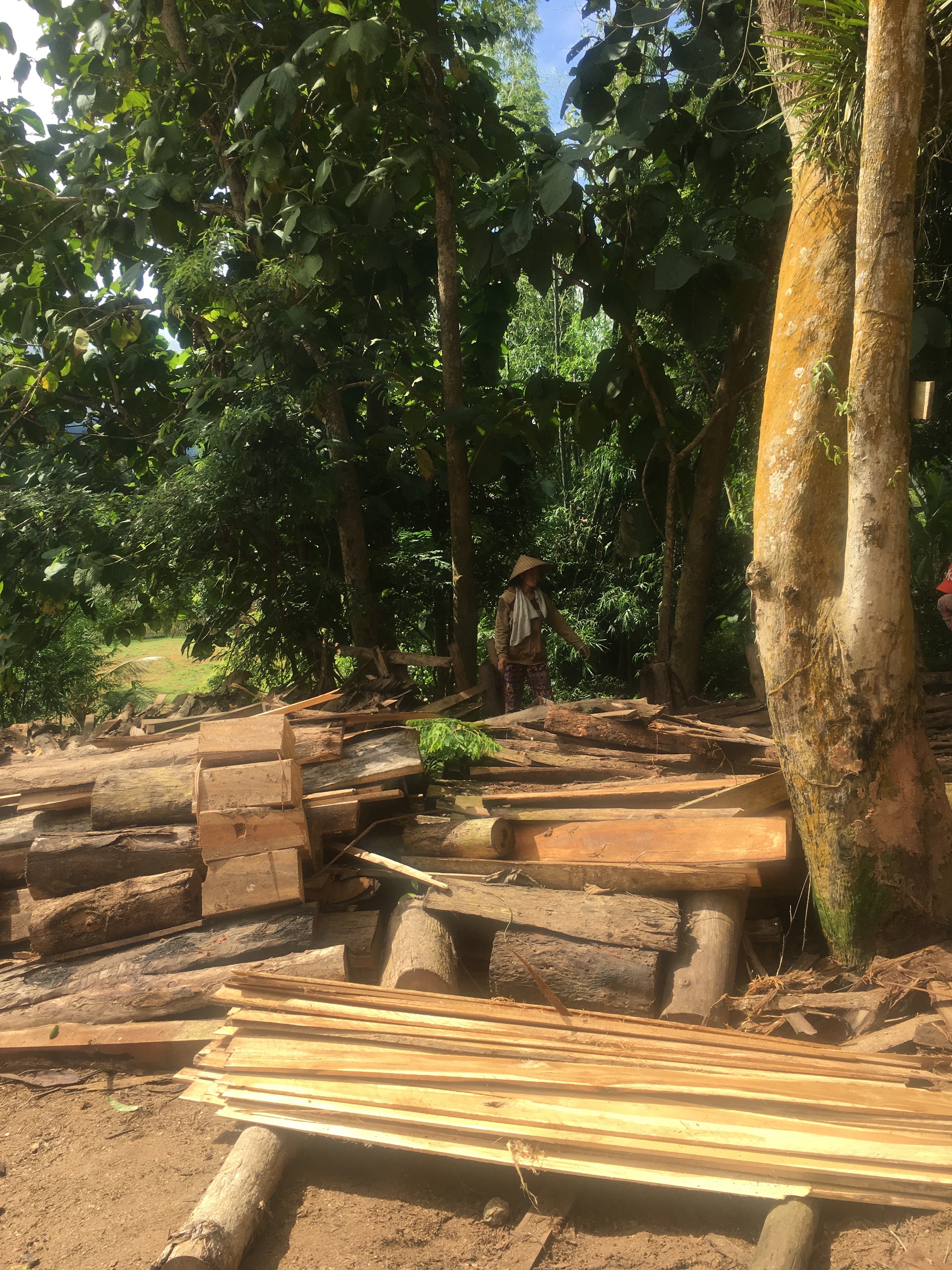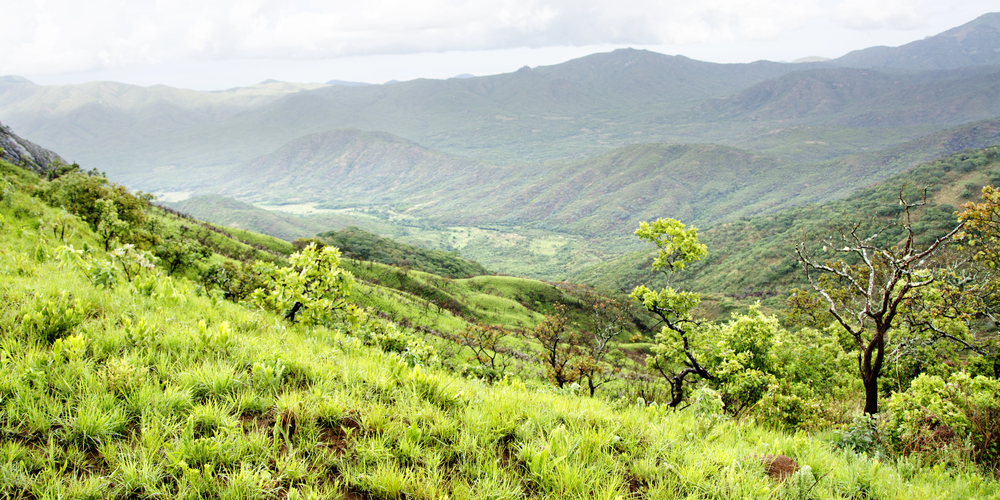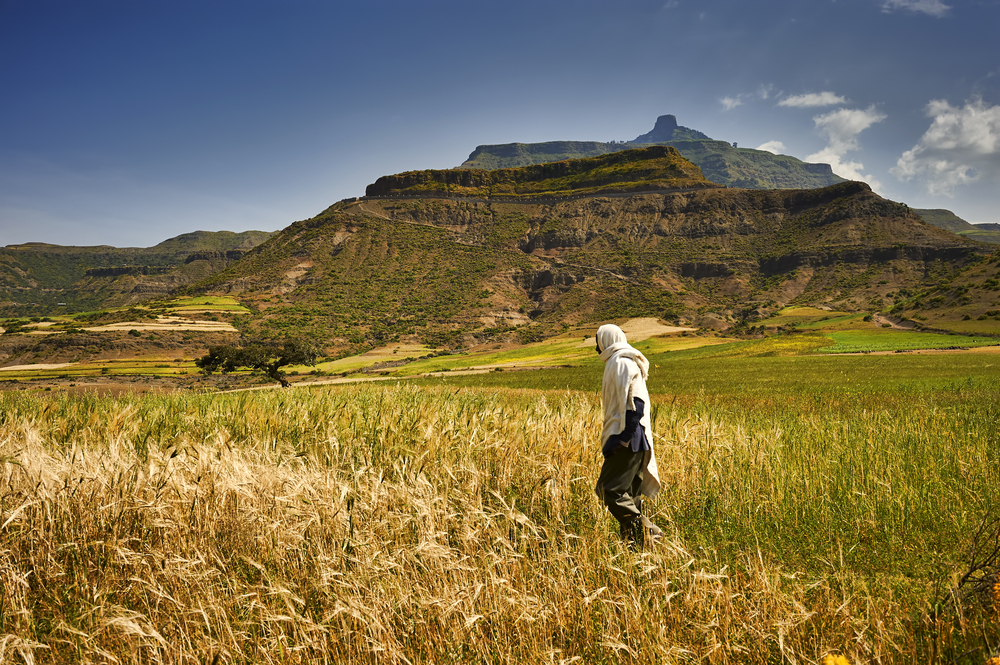landscapes

Being inspired by gender actions in forest landscapes around the world
By Patti Kristjanson (PROFOR) with thanks to Anne Kuriakose (CIF), Meerim Shakirova (FIP), Carlos Cordova (ENR/FIP), Tamara Bah (FCPF), Nicholas Soikan (SURR/FCPF), Haddy Sey (SURR), Margaux Granat (IUCN), Thu Thuy Pham (CIFOR), and Bimbika Basnett (CIFOR)
I recently took this photo of a Laotian woman throwing around pieces of teak wood in a small-scale forest enterprise. This, despite the widespread myth that women are seldom involved in timber and are mostly relegated to gathering forest products. The fact is, we still don’t know much about where and how much women are involved, and more importantly, what opportunities are being missed by largely ignoring half the population living in and around forests. (Oh, and that teak was so cheap, I wanted to take a couple of suitcases of it home with me!)
Just how are forest landscape projects addressing gender-related challenges and opportunities? A recent knowledge-sharing event in Lao PDR, which brought together some 150 participants from over 40 countries, was a good place to pose this question.
We learned that countries as diverse as Laos, Mexico, Ghana, Ecuador, Cameroon, Uganda, and Ghana have been creatively addressing gender constraints and opportunities.
Some specific gender-responsive strategies being pursued in Mexico include creating a gender unit in the main forest agency, and a gender network reaching all states; promoting an institutional culture with a gender perspective; and creating Mexico’s first female fire protection brigade.
Another promising initiative is the Forest Investment Program’s Dedicated Grant Mechanism (DGM), an $80 million program designed and led by representatives of indigenous peoples’ groups and local communities. Indeed, many countries are struggling with how best to make funds available to local communities with promising sustainable forest management and related initiatives.
Meanwhile, Mozambique’s DGM for Local Communities has established a National Steering Committee with several female members - including the Vice President and a representative of the Mozambican Rural Women's Movement - and set a target of at least 40% women’s participation for projects to receive support. Other efforts include promoting systematic community land delimitation and individual titling that is gender-responsive, with both husbands’ and wives’ names registered on land documents.
And in Peru, one-third of DGM funds are targeted to indigenous women’s organizations, right from the design stage. One of the lessons from Peru is that strong ‘umbrella’ indigenous organizations that link to many local communities are extremely helpful, compared to trying to work with many small projects/communities
We also learned at the knowledge-sharing event that the Forest Carbon Partnershp Facility (FCPF), the International Union for Conservation of Nature (IUCN) and others have been supporting national climate change and REDD+ gender action plans in Mexico, Ghana, Uganda, Cameroon, Brazil, Mozambique, and Guatemala. These use participatory, bottom-up approaches along with analyses of legislative and policy frameworks and institutional initiatives on gender and climate change. Implementation is stalling in many places, however, due to a lack of dedicated project funds to gender-targeted activities. In Guatemala, for example, capacity needs and knowledge issues loom large, as in other countries. The need for financial mechanisms for local actors – both men and women – to be able to access private banking resources was also flagged.
In addition, we heard from Nepal, where each parish (50-100 households) has a forest user group whose elected committee must be at least 50% female, and either the vice-president or secretary must be female. Encouragingly, new rules require both women and men to be signatories on bank accounts.
And a key lesson from Vietnam’s REDD+ participatory community-based mapping efforts supported by FCPF is that women’s knowledge is key and must be incorporated into local forest management plans and by-laws on forest use.
It is apparent that many efforts, in many countries, are focused on being more inclusive and making sure women, indigenous peoples, and other less traditionally empowered peoples are involved in REDD+ and other forest-related planning processes. This is a great first step. But we also need to see more innovative and equitable benefit-sharing and empowerment strategies incorporated into forest landscape initiatives. We are starting to see some encouraging examples; it is a challenge well worth accepting.
For stories and updates on related activities, follow us on twitter and facebook , or subscribe to our mailing list for regular updates.
Last Updated : 06-16-2024

Ecological restoration, critical for poverty reduction
By Joaquim Levy, World Bank Group Managing Director and Chief Financial Officer
Why is ecological restoration so critical to the World Bank’s mission of reducing poverty and boosting shared prosperity? Quite simply, because environmental degradation is devastating to the most vulnerable communities![]() and perpetuates poverty around the world.
and perpetuates poverty around the world.
Some 42 percent of the world’s poorest live on land that is classified as degraded. The situation becomes worse every year, as 24 billion tons of fertile soil are eroded, and drought threatens to turn 12 million hectares of land into desert.
The costs associated with environmental degradation can be compared to the impacts of a natural disaster.![]() In Indonesia, for example, a few months of peat fires created more economic damage than the Tsunami in Aceh.
In Indonesia, for example, a few months of peat fires created more economic damage than the Tsunami in Aceh.
Thankfully, there is still time to reverse this type of harm. Worldwide, about two billion hectares of degraded forest land could be restored, creating functional, productive ecosystems that can boost sustainable development. Governments and other stakeholders are motivated to make this happen – nothing was clearer from my participation in the 7th World Conference on Ecological Restoration, last week in Foz do Iguaçu, Brazil.
So how do we take the next step and make large-scale environmental restoration a reality? We need to keep a few key principles in mind:
First, we need to think of a new forest economy. Environmental restoration at the scale we need requires going beyond conservation.![]() It means integrating timber and food production, as well as energy and disaster risk management, particularly when it comes to water resources. We need to look at countries like Austria, Germany and South Korea, which have built entire rural economies on high-tech forest value chains that are not only highly productive, but also ecologically meaningful. The World Bank has supported this approach in several places, including China, where an erosion control project returned the devastated Loess Plateau to a thriving landscape that supports sustainable agriculture and the livelihoods of 2.5 million people.
It means integrating timber and food production, as well as energy and disaster risk management, particularly when it comes to water resources. We need to look at countries like Austria, Germany and South Korea, which have built entire rural economies on high-tech forest value chains that are not only highly productive, but also ecologically meaningful. The World Bank has supported this approach in several places, including China, where an erosion control project returned the devastated Loess Plateau to a thriving landscape that supports sustainable agriculture and the livelihoods of 2.5 million people.
Second, we need to find efficient, low-cost restoration solutions that can be brought to scale. This means investing in rigorously tested scientific methods, because we cannot afford to make large-scale mistakes. It also requires customized solutions capable of meeting the various restoration challenges, from evaluating whether native species are always the best choice, to considering a range of time horizons. Brazil’s commercial restoration sector is a leader in this field, with cooperative, inter-company research contributing to the success of the commercial plantation sector.
Third, we need to ensure legal rights for forests. There can be no thriving forest economy without sound tenure rights, including for Indigenous and traditional peoples. Some countries are making progress on this front. In Nicaragua, for instance, all ancestral territories of Indigenous Peoples in the Caribbean Region are now mapped and titled thanks to legal, policy, and institutional reforms that began 15 years ago, with World Bank support.
Fourth, we need to better understand the value of our forest services. Adopting natural wealth accounting that values assets such as land, forests, and minerals as a companion to GDP would help state the economic cost of degradation and the benefits of restoration. Armed with such information, Ministers of Finance may become restoration champions, and governments would have the tools to develop a forest-smart approach that works across economic sectors and at the right scale. Consider the case of Costa Rica: by establishing forest accounts, the government documented that forests contributed close to 10 times more to GDP than was previously thought.
The last missing link is financing. We need to consider all levels of financing, starting with small and medium-sized enterprises. Forest development and integrated agriculture need to be made attractive to entrepreneurs![]() , including women and the young.
, including women and the young.
In addition, tax and transfer systems must recognize the importance of environmental services. Providing strong governance and guidance on the use of environment compensation fees, such as Brazil’s “compensaçao ambiental,” ought to be a priority. Local solutions need to be discussed everywhere, along with international incentive systems.
Finally, when adequately-funded and accountable research starts to generate the right technology, sizeable financial resources will flow to restoration.
To recap: ecosystem restoration is critical for sustainable development and poverty alleviation![]() ; there are significant opportunities for putting these approaches into practice; and we have a solid understanding of the core principles that contribute to successful restoration efforts.
; there are significant opportunities for putting these approaches into practice; and we have a solid understanding of the core principles that contribute to successful restoration efforts.
At the World Bank Group, we stand ready to support countries’ restoration efforts through our financing tools and partnership programs like the Program on Forests (PROFOR). Together, our efforts can have a transformative impact on improving the lives of the poorest and benefitting the environment.
For stories and updates on related activities, follow us on twitter and facebook , or subscribe to our mailing list for regular updates.
Last Updated : 06-16-2024

When thinking of forests, don’t forget the value of trees
Across the globe, demand for wood products is increasing and expected to quadruple by 2050. This trend is exacerbating deforestation and forest degradation. But it also presents an opportunity for a better approach to farming and managing forests.
A new report, Harnessing the Potential of Private Sector Engagement in Productive Forests for Green Growth, shows how sustainably harvesting wood products can help meet growing demand while providing jobs, mitigating climate change and conserving primary forests.
While it’s well known that trees and forests provide an important carbon sink, the carbon stored in forest products is often overlooked. Forest products and materials such as those used for construction and furniture store carbon for decades and even centuries.
Choosing wood products over other non-renewable materials, such as concrete and steel for construction materials, also offers climate benefits. Concrete and steel require fossil fuel to produce, making these alternatives much more carbon intensive. For example, producing a concrete wall puts 15 times more carbon dioxide into the atmosphere than making a wooden one.
The new report, funded by the Climate Investment Funds (CIF) and the Program on Forests (PROFOR), examined the economies of six countries - Ethiopia, Colombia, Mexico, Mozambique, Peru and Vietnam - to estimate the potential climate mitigation benefits from forest-based supply chains. Together, the six countries could sequester more than 150 million tons of CO2e (see table below) by 2030 with adequate investments in forest restoration and the increased production and use of wood products. Such an approach could help countries meet their climate commitments under the Paris Climate Agreement.
Investing in wood supply to meet demand through landscape restoration and other means also brings benefits, especially by creating new forest industry jobs in rural areas. Potential employment benefits in the six countries studied are depicted in the table below. In addition, projected demand for wood products could encourage the private sector to make long-term investments in productive forests, plantations, and wood processing.
Moving forward on sustainably harvesting forests is a delicate balance between production and conservation. If promoting forest products leads to deforestation, then climate mitigation is lost. To get the balance right, governments must create an enabling environment through better law enforcement and governance. That would help to protect and more sustainability use forests, improve land tenure, and provide the incentive mechanisms to attract private sector investments. Plantations will be key for renewable energy - sustainable charcoal and wood chips - in the future. Private investors, rural communities and forest owners also need technical assistance to help with forest management and production, as well as easier and quicker access to market information.
“Investing in sustainably managing and using forests offers longer-term benefits over the frequently under-productive and disorganized use of many forests today,” says Gerhard Dieterle, program manager for the World Bank’s Forest Investment Program. “As found in this study, doing so would unquestionably benefit people and the planet.”
Click here to watch the video on the interview with the authors.
For stories and updates on related activities, follow us on twitter and facebook , or subscribe to our mailing list for regular updates.
Last Updated : 06-16-2024

Impact Evaluation of Landscape Programs in Ethiopia
PROGRAM SUMMARY
The overarching goal of this project is to assess the impact of landscape programs on livelihood and resilience outcomes in Ethiopia and inform the future design of the programs. Overall, the study seeks to understand the effects of the landscape programs on the outcomes such as household livelihoods, diversification of income generating activities, agricultural productivity and resilience to extreme events.
CHALLENGE
The World Bank has been investing for landscape programs in Ethiopia. Despite of the large investments in this area of work, there is little evidence to understand the impact of the landscape projects financed by the World Bank on household livelihoods and resilience. Further understanding and evaluation of impacts of the landscape programs is important for the design of the future investments in Ethiopia and other countries.
APPROACH
- Research Topic 1: Estimating impacts of the land restoration program on livelihoods and resilience in Ethiopia
- Research Topic 2: Impacts of land restoration program on agricultural productivity and production diversity during and after the 2015/16 severe droughts in Ethiopia
- Research Topic 3: Use of satellite remote sensing SIF observations to estimate the effects of land restoration programs on land productivity and resilience
- Main report for policy-makers and general audience
- Supporting technical report
- Collected and cleaned key datasets required to assess the impact of the Ethiopia landscape program from both economic and physical aspects
- Developed robust econometric and scientific approaches to measure the program impact
- Established the key collaboration with the International Food Policy Research Institute (IFPRI) to carry out the study. This collaboration is extremely useful as we conduct the impact evaluation of landscape programs in other countries, utilizing the experience and methodology established through this activity.
For stories and updates on related activities, follow us on twitter and facebook , or subscribe to our mailing list for regular updates.
Last Updated : 06-15-2024








